Brick by Brick
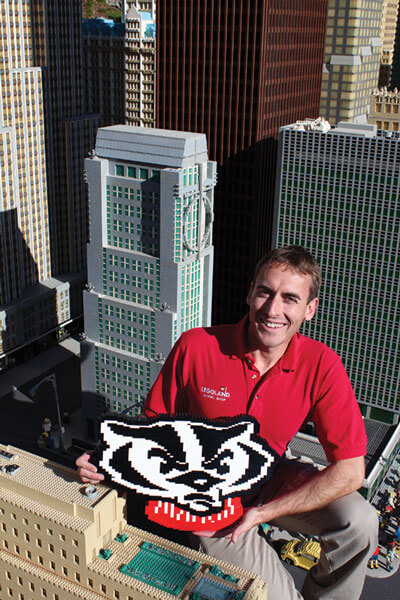
While studying urban and regional planning at UW–Madison, Ryan Ziegelbauer learned skills that help him maintain miniature Lego architectural models of major U.S. cities, including New York. And that Lego Bucky he’s holding? Scroll down to find out how he built it. Courtesy of Legoland California Resort.
With a passion for a very popular toy, Ryan Ziegelbauer is building miniature marvels — and a career.
Ryan Ziegelbauer’s workplace is a child’s dream realized: the nine-foot walls surrounding him are stocked floor to ceiling with Lego pieces of every color, shape, and size. In his role as a master model builder for Legoland California Resort in Carlsbad, California, he gets to create things that transcend dreams. “Imagine — building eight hours a day, for five days straight — what you can accomplish with an unlimited number of parts,” says Ziegelbauer MS’06. “It is quite amazing.”
When he began working at Legoland in 2010, his first big assignment was to construct models of characters and scenes from the Star Wars movies, including Han Solo and the X-Wing.
Allow your inner child to let that sink in.
Although most kids love building with Lego pieces, their passion often fades as childhood ends. That was true of Ziegelbauer, too, until his twentieth birthday, when a friend gave him a Life on Mars set, complete with a spaceship and little green aliens. The gift induced an epiphany of sorts: “You don’t have to put this on the shelf; you don’t have to leave this back to when you were twelve,” he realized. “You can continue to build.”
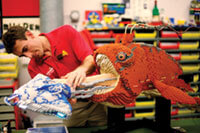
Ziegelbauer has worked for Legoland since 2010. One of his first assignments was to construct models of characters and scenes from the Star Wars movies, including this 20,000-brick giant opee sea killer found on the planet Naboo in Star Wars Episode I: The Phantom Menace. Courtesy of Legoland California Resort.
When Lego bricks re-entered his life, Ziegelbauer was studying urban geography and urban planning as an undergraduate at UW–Milwaukee. He learned how to do computerized mapping, and he worked as an intern at the Nonprofit Center of Milwaukee, where he mapped public health issues, such as cases of lead poisoning in children, teenage pregnancy, and asthma.
His fascination with all things Lego continued on a post-college trip to Europe, where he visited Legoland in Windsor, England, and marveled at the huge models. “It really expanded my mind, and I thought, ‘Wow, there’s huge, huge Lego models here, and how cool would it be to build these things?’ ” he says. “In the back of my mind, I always thought this would be a great dream job.”
His next stop was Madison, where he worked as an instrument technician, setting up operating rooms at UW Hospital and Clinics.
He took German, urban planning, and computer programming classes at UW–Madison before enrolling in a full-time master’s program in urban and regional planning. Ziegelbauer focused on land use, indoor-air quality, and sustainable construction. He also attended free classes offered by the campus’s Division of Information Technology and learned how to use Adobe Illustrator and Photoshop — software he still uses today to design Lego creations ranging from miniature cities to zombies.
He decided to join Hoofers Sailing Club, which proved serendipitous: to this day, he says, he calls upon the nautical knowledge he gained there to ensure that the rigging on Lego’s miniature sailboats is authentic. “I never thought [what I learned] would apply to a job — unless I was a professional sailor of some sort,” he says.
In spring 2006, as he was finishing his degree, Ziegelbauer entered Lego’s nationwide Master Model Builder search. First prize: that dream job. He survived the early rounds in Chicago, impressing judges by building a pirate brandishing a knife and flashing a mouth of gold teeth. From there, he went to Legoland California for a three-day “build-off,” an exhausting marathon of timed building challenges and interviews. Each night, he stayed up late in his hotel room, building models and planning what to tackle the next day. “We had to build under pressure,” he says. “It was almost like a reality show.”
He didn’t win, but he kept building and getting better.
Ziegelbauer moved three times that year — from Madison to Milwaukee, and then to Weaverville, California, for a short-term job doing airport-use planning, before starting a new position in Berkeley. His list of must-haves for an apartment included an unusual item: studio space to build with the Lego collection he and his younger brother had amassed during their childhood. It filled a large duffle bag — weighing in at seventy-nine pounds — that he moved halfway across the country from his parents’ home in Johnsburg, Wisconsin.
He had just built a table and shelves for his new studio when Legoland California called. The park needed additional help on a large project, and, based on his performance in the competition nine months earlier, they wanted to hire him.
He said no. (This is not a typo.)
Ziegelbauer had just started his new job with Build It Green, a startup nonprofit that supports sustainable construction — work directly connected to his master’s degree.
“I had to turn [Lego] down. … But it ate at me, as you might imagine — offering me a full-time job, getting paid to build Legos, and I [had] said, ‘No.’ I thought, ‘Well, if they wanted me then, maybe they’ll want me in the future,’ ” he recalls.
He spent two years at Build It Green before taking a job in the city of San Francisco’s capital planning department. He commuted by train from Berkeley, continuing to build Lego models in his spare time, filling the shelves of his studio.
After four years, three jobs, and a lot of Lego building in his free time, Ziegelbauer decided to tackle the dream he had deferred. He returned to Legoland California for another Master Model Builder competition in 2010. This time, he got the job and the access to “unlimited brick” (as he calls it) that comes with it.
There are always models to build. At Christmastime, builders create a tree using 250,000 Duplo bricks, the larger Lego pieces designed for younger children. Zombies and skeletons crawl out of a New Orleans cemetery at Halloween, a holiday that Ziegelbauer got hooked on during his time at the UW.
Legoland California is also home to 1/20-scale architectural models of major U.S. cities, including Las Vegas, New York, San Francisco, and Washington, D.C. He recently worked on refurbishing the Lego models that make up New Orleans, a city he first visited the year before Hurricane Katrina hit. He had returned on a spring break trip with the Wisconsin Union Directorate’s Alternative Breaks program to help clean up the devastation, and he fell in love with the place.
“I really got to know the city, got to know all different corners of it — parts that tourists don’t really go to very often,” he says. “When we refurbished [the Lego model], it was kind of a personal thing for me.”
Ziegelbauer frequently calls upon his urban-planning skills, using computer-aided design tools similar to what architects, engineers, and city planners employ, to draw plans for new Lego models or to modify current ones to make them more authentic. For the New Orleans Miniland, he laid out new streets patterned after the city’s Ninth Ward. He examined the ward’s sidewalks and how far homes are set back from the street to recreate a streetscape with approximately the same scale.
“We want it to be as realistic as possible,” he says. “When I look at the electronic version of it, it doesn’t look too much different from how a real city might look.”
Although his job has room for play, Ziegelbauer says it also pushes him beyond what he imagined he could do when he first landed the position. His ultimate goal is to design a new Legoland city or a first-of-its-kind airport from top to bottom.
“Most artists would say that they might never be satisfied with their projects,” he says. “They want to move on to the next thing and make something better. It’s a drive that might never go away — and that exists, definitely, for me at this job.”
Jenny Price ’96 is the mother of a seven-year-old Lego model builder.
Published in the Summer 2013 issue
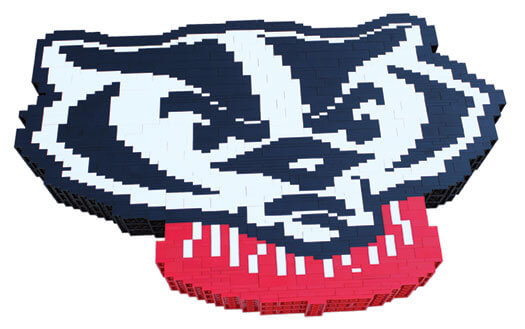
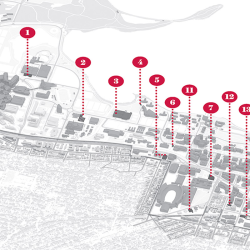
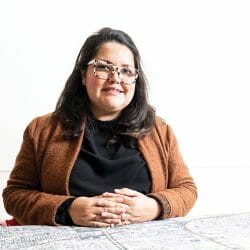
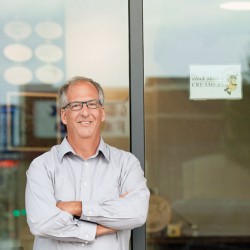
Comments
Dan July 31, 2013
Is there any way to find out where to buy or how to build that Bucky? It combines two of my favorite things; Legos and Wisconsin pride! What a neat idea!
Wendy August 3, 2013
Build your own Bucky! It’s simply 2D, so just zoom in on a low resolution digital Bucky as a guide… each pixel is a brick. Pretty simple with only 3 colors.
Rhonda - UW Alumni August 4, 2013
Ryan, you should talk to Lego’s and market the pattern on this. Just think of the possibilities. College, NFL, Wrestling, Golf Logos. I’m a Bucky FANatic! This would be great to make with my 3 year old son. He has attended the U.W. with me since he’s been born! Good Work! Great Thinking! You have a Bright Future Ahead. Good Luck! (This also looks like FUN!)
Moni Kellermann October 13, 2013
His name “Ziegelbauer” literally means “brick builder” in German! 😀
Liz February 24, 2014
Would love to buy this Bucky Badger set. I would also like a Green Bay Packer helmet. I’m with Rhonda, think of the NFL helmet possibilities… Come on lego, don’t you want to expand your market to lego loving adults too?